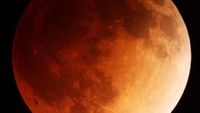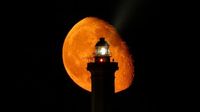August 2025 promises a spectacular celestial show for skywatchers around the globe, featuring the captivating "Sturgeon Moon," multiple meteor showers, and notable planetary alignments. As the nights grow longer, enthusiasts can look forward to a month rich with astronomical events that blend science, history, and natural beauty.
Starting the month, the moon is in its waxing gibbous phase, approximately 60% illuminated as of August 2, 2025. This phase marks day nine of the lunar cycle, which spans about 29.5 days, a rhythm dictated by the moon’s orbit around Earth and its changing angles with the Sun, as explained by NASA. During this waxing gibbous phase, observers can enjoy views of prominent lunar features such as Mare Fecunditatis, Mare Tranquillitatis, and Mare Crisium with the naked eye. For those equipped with binoculars or telescopes, the lunar Alps, Apennine Mountains, and the Aphonsus Crater come into focus, while more advanced instruments reveal the Rima Arladaeus, Descartes Highlands, and Rupes Altai.
One of the highlights of August’s lunar journey is the full moon known as the "Sturgeon Moon," which peaks at 3:55 a.m. Eastern Time on August 9, 2025. This moon earns its name from the lake sturgeon, a giant freshwater fish historically abundant in the Great Lakes, Mississippi River Basin, and Lake Champlain regions. The Old Farmer's Almanac notes that Native American tribes and early settlers relied on these fish as a vital food source during late summer, although overfishing and environmental factors have since rendered the species rare. Lake sturgeon can grow over six feet long and weigh approximately 200 pounds, making them a formidable presence in North American freshwater ecosystems.
In Binghamton and similar latitudes, the optimal time to observe the Sturgeon Moon is about an hour before sunset on August 8, around 7:15 p.m., according to local astronomical recommendations. The moon will rise around sunset on August 9, casting its full glow across the night sky. This full moon phase is part of a series of lunar phases for August 2025, which include the first quarter on August 1, last quarter on August 16, new moon on August 23, and another first quarter on August 31.
August’s moon offers more than just its phases; it presents a celestial canvas for exploring the moon’s geological wonders. The first quarter moon on August 1 brings the lunar terminator—the dividing line between lunar night and day—into sharp relief, making features like Mare Tranquillitatis, the site of the historic Apollo 11 landing, easily visible. The Apollo 11 mission famously touched down on July 20, 1969, at Tranquility Base, a moment immortalized by Neil Armstrong’s words, "the Eagle has landed." Observers with a 6-inch or larger telescope can pinpoint this landing site near the Ritter and Sabine craters.
By August 4, the moon’s terminator will create the striking "Golden Handle" effect, where sunlight illuminates the Montes Jura mountain range along the northern edge of Mare Imbrium. This natural spectacle appears as a bright arc against the shadowed lunar surface, a favorite target for amateur astronomers.
The Sturgeon Moon itself showcases the prominent Tycho crater, a vast 53-mile-wide impact site formed approximately 108 million years ago. Tycho’s bright ray system, composed of reflective material ejected during the asteroid impact, radiates across the lunar surface and remains visible to the naked eye. This contrasts with older craters, some dating back 3.9 billion years, whose rays have faded over time. The full moon also highlights several lunar maria—basaltic plains formed by ancient lava flows—including Mare Crisium to the northeast, Mare Tranquillitatis and Mare Serenitatis nearby, and the expansive Oceanus Procellarum dominating the western equatorial region.
Following the full moon, the third quarter phase on August 16 offers a dramatic interplay of light and shadow along the terminator, perfect for observing craters like Plato and Archimedes. Plato, measuring 62 miles across, lies just below Mare Frigoris, while Archimedes rests above the Montes Apenninus mountain range. The subsequent night, August 17, reveals the Copernicus and Kepler craters, both surrounded by bright ejecta rays and notable for their striking appearance under oblique sunlight. Copernicus was once considered as a potential Apollo landing site but was never visited due to mission cancellations.
The lunar cycle culminates in the new moon on August 23, when the moon’s dark side faces Earth, leaving the night sky free from lunar glare. This phase is ideal for stargazing, especially for viewing the Milky Way’s core, which becomes visible in dark sky locations during summer evenings. Around this time, observers may notice Earthshine, a faint glow on the moon’s darkened surface caused by sunlight reflected from Earth, sometimes called the "Da Vinci Glow."
August 2025 is also a banner month for meteor showers. The Perseid meteor shower, active through August 23, peaks spectacularly on the night of August 12-13. This shower can produce 50 to 75 shooting stars per hour under optimal dark sky conditions, though this year’s bright moonlight from the Sturgeon Moon may slightly dim the spectacle. The Southern Delta Aquariids and Alpha Capricornids meteor showers, which peaked around July 29-30, continue to offer viewing opportunities into early August. The Alpha Capricornids are especially noted for their bright fireballs, while the Delta Aquariids provide a steady stream of meteors.
Planetary activity adds to the August skywatching excitement. Venus and Jupiter will engage in a close conjunction on August 11 and 12, shining just a degree apart in the eastern pre-dawn sky. This "summer kiss" of planets is a rare and beautiful sight, easily visible without telescopes. Meanwhile, Mercury emerges from its retrograde phase on August 11, having appeared to move backward in the sky since July 17. This optical illusion occurs as Earth overtakes Mercury in their respective orbits around the Sun and is often associated with disruptions in communication and technology, according to astrological tradition.
Finally, the M27 planetary nebula will grace the Summer Triangle—a prominent asterism formed by the bright stars Deneb in Cygnus, Vega in Lyra, and Altair in Aquila—visible high in the night sky during the first half of the night. This nebula, also known as the Dumbbell Nebula, is one of the easiest planetary nebulae to observe and adds a deep-sky highlight to August’s celestial lineup.
In sum, August 2025 offers a rich tapestry of lunar phases, meteor showers, and planetary events that invite both casual observers and dedicated astronomers to look skyward. Whether it’s the historic significance of the Apollo 11 landing site illuminated by the first quarter moon, the glowing rays of Tycho crater during the Sturgeon Moon, or the fleeting brilliance of Perseid meteors streaking across the night, this month’s sky is a compelling reminder of the wonders orbiting above us.





